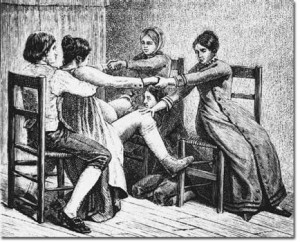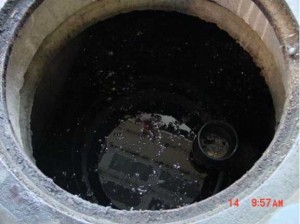Injection Wells
It Happened Last Night
 Azle area families are proud to announce the birth of their new grassroots group, and movement, born last night around 8:30 pm, CST.
Azle area families are proud to announce the birth of their new grassroots group, and movement, born last night around 8:30 pm, CST.
It's so new, the 300 or so parents haven't had a chance to name it yet. But it does have a mission: challenging the Barnett Shale status quo.
There's an air of mystery surrounding how these things happen. Many people don't want to be in the room when it actually occurs. Many get nervous. Sometimes it gets messy.
But it's really quite a simple procedure and last night the delivery room was primed for quick and decisive action by two earthquakes in the last 24 hours. No prolonged labor this time. When the call went out to fill the ranks of a local steering committee, bodies shot up out of chairs and spoke their names into the mic for posterity. Male and female, booted and sneakered, grandparents and their grandchildren, Black, Anglo and Hispanic. At the end, approximately 20 volunteers stood in front of the crowd receiving a thankful ovation from their peers.
There are few more poignant moments you can witness in American democracy than the birth of real citizenship.
The newcomer will be taking its first baby steps very soon – at least one bus is being chartered to go to the next Railroad Commission meeting in Austin this next Tuesday, January 21st, and speak to the need of immediate help versus the delay and more study approach of the state. The meeting begins at 9:30am. Details are being worked out now, but the parents say you don't have to be from the Azle area to join the Austin protest. It takes a region to raise a ruckus.
Congratulations to the parents. May their offspring grow up to be strong and smart, and know how to do its job in the shortest amount of time possible. Here's some sample news coverage of the birth:
“We don’t really know, 8,000 feet below, where the waste goes”
 That's Texas Supreme Court Justice Paul Green blurting out an unfortunate truth even as he was trying to defend an injection well that's being sued for trespassing into groundwater under an adjacent rice farm in Liberty County near the Texas gulf coast.
That's Texas Supreme Court Justice Paul Green blurting out an unfortunate truth even as he was trying to defend an injection well that's being sued for trespassing into groundwater under an adjacent rice farm in Liberty County near the Texas gulf coast.
The Texas Tribune's Jim Malewitz has the scoop on a so far mostly over-loooked case that could set some important precedents about land rights and underground contamination. How do we know? Because the oil and gas industry told Maelwitz:
In 1997, Environmental Processing Services finished drilling an injection well about 400 feet from FPL Farming’s land, which the farm contested early on. Since then, the company has injected more than 100 million gallons of wastewater, gradually expanding the well's underground footprint.
The well in question is labeled Class I and used for nonhazardous industrial waste. It is not one of the 50,000 Class II wells that drillers typically use. But lower-court opinions have drawn no distinction between the wells. That has stirred concerns among oil and gas producers that a ruling in the farm’s favor would complicate efforts to dispose of drilling waste, thereby stalling production.
“Because the ability to produce oil and gas is inextricably tied to the availability of injection wells,” the Texas Oil and Gas Association says in a brief, “a new common law cause of action that threatens operation of injection wells likely threatens oil and gas production."
As Malewitz points out, the case raises the questions of "just how far below the earth’s surface do property lines extend? And can someone trespass on another’s property — more than a mile underground?"
Since it's close to the coast, the farm's groundwater is too salty to drink now but the farm's lawyers argue that desalinization technology could render the water useful. They say regardless of its salinity, it's a resource and a piece of private property that's being poisoned by the well's waste stream that includes the flammable liquid acetone.
Now you may think the waste well operators, "Environmental Processing Services," would deny any contamination of the farm's water as a first line of defense. But as it turns out everyone in industry and the regulatory agencies believes that after you've pumped 100 million gallons of industrial waste down a hole 800 feet deep, it will tend to "migrate" outside the fence line of the well itself. So what kind of arguments are EPS's lawyers that the Texas Supreme Court is finding so persuasive?
1) Our waste may be migrating, but since we can't go down there and check, you really can't conclusively prove that it's under the farm…yet. All you have is an industry-government model that everybody uses that says it has.
2) The water is already polluted with too much salt, so there's no way you can pollute already polluted water. So there.
3) Even if it is polluted by our waste, maybe that same desalinization technology the farm wants to use to make the water useable will also be able to filter our industrial waste out if it.
Of course, these equivocating arguments in court by lawyers are a far, far cry from the air-tight assurances Texans get from the industry spokespeople or slavishly pro-industry elected officials, who GUAR-AN-TEE that no fracking waste injection well could ever contaminate groundwater.
Really. You should go read the article. The lawyers are making lots of money on this one. No timeline for a ruling.
Was Azle the Barnett Shale’s “Walter Cronkite Moment?”
 When Walter Cronkite announced that America was losing the war in Vietnam, LBJ knew he'd lost Middle-America.
When Walter Cronkite announced that America was losing the war in Vietnam, LBJ knew he'd lost Middle-America.
When the gas industry is losing the editorial board of the Fort Worth Star-Telegram, is it a sign it's losing the PR war in the Barnett Shale?
While Sunday's editorial in the Star-Telegram, titled "Texas Railroad Commission can’t just tippy-toe around quakes" falls far short of a wholesale condemnation of urban injection well operations, it does castigate the Railroad Commission for being promoters of fracking while also being assigned to regulate it on behalf of the public good, and faults it for failing to provide any new facts to the debate at its disastrous public meeting last week in Azle.
Is the three-member commission doing anything to separate facts from speculation and theories?
“In addition to taking the residents’ comments into serious consideration, Commissioner Porter has been in communication with the state geologist in regards to a potential study by the Bureau of Economic Geology,” Porter’s news release said. “Railroad Commission staff is also participating in a work group formed by the Environmental Protection Agency, which includes representatives from the United States Geological Survey and other state regulatory agencies.”
There’s “serious consideration,” a “potential study” and a “work group.” Sounds like tippy-toeing.
In fact, there is a considerable amount of science linking disposal wells, which push millions of gallons of drilling waste into rock formations deep under ground, with “induced” earthquakes.
A report posted in July described one study by USGS scientists. The results were also published in the journal Science.
The rate of quakes increased to about 100 a year in the central and eastern U.S. in the three-year period from 2010 through 2012, up from an average 21 a year from 1967-2000, the study showed. The increase coincided with a rapid increase in oil and gas drilling using hydraulic fracturing, which leaves large amounts of waste water for disposal.
In many ways, the developments in Azle last week represent a bigger threat to the industry than residents' December victory in Dallas over a more protective gas drilling ordinance. It's deep in the heart of the urban Shale instead of being at its edge. It's a spontaneous grassroots revolt led by people who probably voted for Ted Cruz instead of Paul Sadler in 2012. Its participants have lived with fracking for almost a decade now instead of fighting off an invasion as in Dallas. These are folks who are more likely to carrying a concealed weapon than a Sierra Club membership.
It's also true that both industry and government have been caught off-guard by the issue of injection-well earthquakes and are unable to bat down the arguments the way they can with harms that take more time, and have more subtle causal links, like cancer. Empirical evidence makes the case pretty plain, as the Star-Telegram editorial admits. Denials by industry in the midst of earthquake "swarms" centered on injection well locations seem like the environmental equivalent of a reassuring "Baghdad Bob" show while the bombs are falling in the background.
Do the circumstances taking place in the western part of the Metromess represent a new front on the fracking fight in North Texas, or just a momentary rise in tensions that will be gone by the Spring? A lot depends on whether the pace of earthquakes that gave rise to the Azle meeting keep occurring. Thirty of them have been recorded since November alone and if they keep showing up at that rate, there'll be little need of community organizing meetings to get people motivated to do something. The question is what that something is.
A prohibition on injection wells within Standard Metropolitan Areas? Within certain population densities? Within proximity of water wells and infrastructure? A moratorium on any new wells anywhere? Is there and answer that can help the people in Azle and maybe others in the Shale at the same time?
Time will tell whether last week's meeting is a real turning point for facts on the ground, but it's already clear that it marked a milestone in terms of perception. And as we're often fond of saying here at Downwinders, perception is everything.
